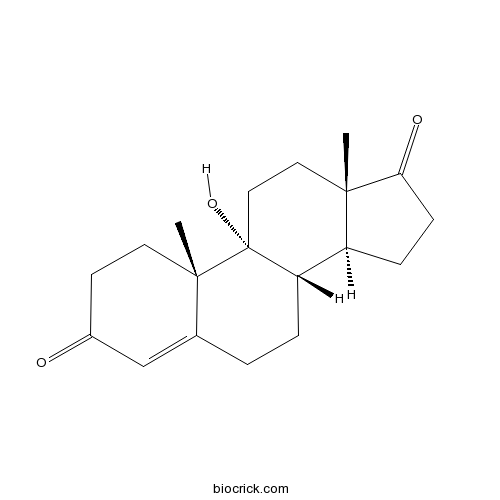9-Hydroxy-4-androstene-3,17-dioneCAS# 560-62-3 |

Quality Control & MSDS
3D structure
Package In Stock
Number of papers citing our products

| Cas No. | 560-62-3 | SDF | Download SDF |
| PubChem ID | 10425017 | Appearance | Powder |
| Formula | C19H26O3 | M.Wt | 302.4 |
| Type of Compound | N/A | Storage | Desiccate at -20°C |
| Solubility | Soluble in Chloroform,Dichloromethane,Ethyl Acetate,DMSO,Acetone,etc. | ||
| Chemical Name | (8S,9R,10S,13S,14S)-9-hydroxy-10,13-dimethyl-1,2,6,7,8,11,12,14,15,16-decahydrocyclopenta[a]phenanthrene-3,17-dione | ||
| SMILES | CC12CCC3(C(C1CCC2=O)CCC4=CC(=O)CCC43C)O | ||
| Standard InChIKey | SNMVJSSWZSJOGL-PLOWYNNNSA-N | ||
| Standard InChI | InChI=1S/C19H26O3/c1-17-9-10-19(22)15(14(17)5-6-16(17)21)4-3-12-11-13(20)7-8-18(12,19)2/h11,14-15,22H,3-10H2,1-2H3/t14-,15-,17-,18-,19+/m0/s1 | ||
| General tips | For obtaining a higher solubility , please warm the tube at 37 ℃ and shake it in the ultrasonic bath for a while.Stock solution can be stored below -20℃ for several months. We recommend that you prepare and use the solution on the same day. However, if the test schedule requires, the stock solutions can be prepared in advance, and the stock solution must be sealed and stored below -20℃. In general, the stock solution can be kept for several months. Before use, we recommend that you leave the vial at room temperature for at least an hour before opening it. |
||
| About Packaging | 1. The packaging of the product may be reversed during transportation, cause the high purity compounds to adhere to the neck or cap of the vial.Take the vail out of its packaging and shake gently until the compounds fall to the bottom of the vial. 2. For liquid products, please centrifuge at 500xg to gather the liquid to the bottom of the vial. 3. Try to avoid loss or contamination during the experiment. |
||
| Shipping Condition | Packaging according to customer requirements(5mg, 10mg, 20mg and more). Ship via FedEx, DHL, UPS, EMS or other couriers with RT, or blue ice upon request. | ||

9-Hydroxy-4-androstene-3,17-dione Dilution Calculator

9-Hydroxy-4-androstene-3,17-dione Molarity Calculator
| 1 mg | 5 mg | 10 mg | 20 mg | 25 mg | |
| 1 mM | 3.3069 mL | 16.5344 mL | 33.0688 mL | 66.1376 mL | 82.672 mL |
| 5 mM | 0.6614 mL | 3.3069 mL | 6.6138 mL | 13.2275 mL | 16.5344 mL |
| 10 mM | 0.3307 mL | 1.6534 mL | 3.3069 mL | 6.6138 mL | 8.2672 mL |
| 50 mM | 0.0661 mL | 0.3307 mL | 0.6614 mL | 1.3228 mL | 1.6534 mL |
| 100 mM | 0.0331 mL | 0.1653 mL | 0.3307 mL | 0.6614 mL | 0.8267 mL |
| * Note: If you are in the process of experiment, it's necessary to make the dilution ratios of the samples. The dilution data above is only for reference. Normally, it's can get a better solubility within lower of Concentrations. | |||||

Calcutta University

University of Minnesota

University of Maryland School of Medicine

University of Illinois at Chicago

The Ohio State University

University of Zurich

Harvard University

Colorado State University

Auburn University

Yale University

Worcester Polytechnic Institute

Washington State University

Stanford University

University of Leipzig

Universidade da Beira Interior

The Institute of Cancer Research

Heidelberg University

University of Amsterdam

University of Auckland

TsingHua University

The University of Michigan

Miami University

DRURY University

Jilin University

Fudan University

Wuhan University

Sun Yat-sen University

Universite de Paris

Deemed University

Auckland University

The University of Tokyo

Korea University
- Chlorhexidine acetate
Catalog No.:BCC8912
CAS No.:56-95-1
- Histamine 2HCl
Catalog No.:BCC4530
CAS No.:56-92-8
- (H-Cys-OH)2
Catalog No.:BCC2915
CAS No.:56-89-3
- L-lysine
Catalog No.:BCN7157
CAS No.:56-87-1
- L-Glutamic acid
Catalog No.:BCN3809
CAS No.:56-86-0
- L-Glutamine
Catalog No.:BCC3803
CAS No.:56-85-9
- H-Asp-OH
Catalog No.:BCC2881
CAS No.:56-84-8
- Glycerol
Catalog No.:BCC8990
CAS No.:56-81-5
- Chloramphenicol
Catalog No.:BCC1201
CAS No.:56-75-7
- DL-5-Hydroxytryptophan
Catalog No.:BCN1232
CAS No.:56-69-9
- Quinidine
Catalog No.:BCC7863
CAS No.:56-54-2
- Diethylstilbestrol
Catalog No.:BCC4900
CAS No.:56-53-1
- Eburicoic acid
Catalog No.:BCN2556
CAS No.:560-66-7
- Sucralose
Catalog No.:BCC4725
CAS No.:56038-13-2
- Hispidin
Catalog No.:BCN3567
CAS No.:56070-89-4
- PRIMA-1
Catalog No.:BCC2413
CAS No.:5608-24-2
- 3-Methoxyshancigusin I
Catalog No.:BCC9002
CAS No.:
- Ionomycin free acid
Catalog No.:BCC7261
CAS No.:56092-81-0
- Ionomycin calcium salt
Catalog No.:BCC5805
CAS No.:56092-82-1
- Securinine
Catalog No.:BCN6988
CAS No.:5610-40-2
- Parisaponin I
Catalog No.:BCN2835
CAS No.:561007-63-4
- Asperglaucide
Catalog No.:BCN5748
CAS No.:56121-42-7
- 4-O-Methylhelichrysetin
Catalog No.:BCN3986
CAS No.:56121-44-9
- Valrubicin
Catalog No.:BCC5219
CAS No.:56124-62-0
Mycobacterium tuberculosis is able to accumulate and utilize cholesterol.[Pubmed:19717592]
J Bacteriol. 2009 Nov;191(21):6584-91.
It is expected that the obligatory human pathogen Mycobacterium tuberculosis must adapt metabolically to the various nutrients available during its cycle of infection, persistence, and reactivation. Cholesterol, which is an important part of the mammalian cytoplasmic membrane, is a potential energy source. Here, we show that M. tuberculosis grown in medium containing a carbon source other than cholesterol is able to accumulate cholesterol in the free-lipid zone of its cell wall. This cholesterol accumulation decreases the permeability of the cell wall for the primary antituberculosis drug, rifampin, and partially masks the mycobacterial surface antigens. Furthermore, M. tuberculosis was able to grow on mineral medium supplemented with cholesterol as the sole carbon source. Targeted disruption of the Rv3537 (kstD) gene inhibited growth due to inactivation of the cholesterol degradation pathway, as evidenced by accumulation of the intermediate, 9-Hydroxy-4-androstene-3,17-dione. Our findings that M. tuberculosis is able to accumulate cholesterol in the presence of alternative nutrients and use it when cholesterol is the sole carbon source in vitro may facilitate future studies into the pathophysiology of this important deadly pathogen.
Microbial degradation of the phytosterol side-chain to 24-oxo products.[Pubmed:7210061]
Steroids. 1980 Dec;36(6):723-30.
A mutant of the potent sterol degrader Mycobacterium fortuitum (ATCC 6842) has been isolated which is defective in its ability to degrade both the steroid nucleus and sterol side-chains that are branched at the 24-position. Bioconversions of phytosterol mixtures by this mutant resulted in the accumulation of the novel 24-oxo intermediates 9-hydroxy-27-nor-4-cholestene-3,24-dione (II) and 9-hydroxy-26,27-dinor-4-cholestene-3,24-dione (III). Under the same conditions, cholesterol is degraded mainly to 9-Hydroxy-4-androstene-3,17-dione (I) by this organism.


